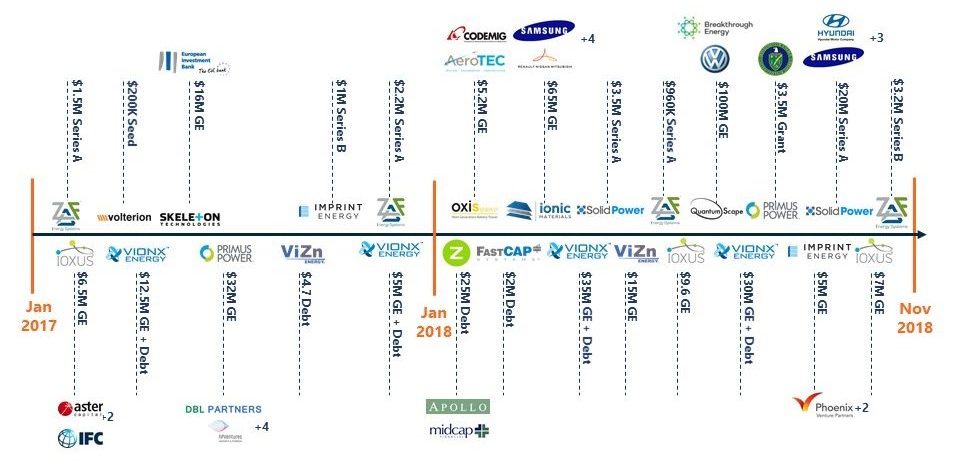Battery Technology Show 电池技术展回顾:新兴电池技术
来自b-science.net的联合创始人兼首席执行官Pirmin Ulmann
上个月,我很幸运在伦敦的电池技术展上进行了一次适度的会议。这是该会议的总结,以及我们自己的研究得出的一些其他见解。
来自电池工业供应链的代表参加了有关可能在未来几年内扰乱市场的技术和商业模式创新的讨论。演讲嘉宾包括主题专家,例如帝国拼贴学院戴森工程学院的高级讲师比利·吴(Billy Wu)和储能专利搜索与监控公司b-science的联合创始人兼首席执行官Pirmin Ulmannm。
远离事件,我感到业界共识是,由于更新电池的出现,液体电解质电池的市场份额将迅速下降。观点的差异在于商业上市的时机。
自1991年投入商业运营以来,液态锂离子的性能一直在不断提高。仅在最近几年中,在大量研发资金的推动下,重大的技术进步才达到了替代电池化学的临界点。在过去的24个月中,风险投资引起了人们的注意,并增加了对固态,超级电容器和氧化还原液流电池的投资活动,并推动了对锌,硫和铅等化学产品的投资回升(如图1所示)。
小组成员还提供了对其中某些技术当今地位的见解。

图1显示了新兴电池技术的投资趋势
固态电池
顾名思义,固态电池利用固态材料来实现锂离子在电池中的传输。 由于缺少合适的电解质候选材料,固态电池先前未能达到预期。 最近在实验室级别获得的增量收益导致各种成功的试点项目。 专家们解释说,虽然如今带有液体电解质的锂离子电池已成为标准,但固体电解质却是非挥发性的,这使固态电池本来就更安全。 它们还具有更高的能量密度。

图2显示了固态电池系统
2018年2月,包括雷诺,日产,三菱和戴森在内的汽车OEM共同向固态电池初创公司Ionic Materials投资了6500万美元。 Solid Power还筹集了2000万美元用于2019年生产设施的准备,并准备与一系列战略合作伙伴保持可持续增长。 QuantumScape于6月份从大众汽车公司获得了1亿美元的投资,尽管该公司没有商品化的证据,但该公司使该公司处于早期的“独角兽”地位。
专家小组总结说,固态电池可能被大肆宣传,他们将关注表现不佳的技术进步,即使在大规模部署之后,也会为固态电池的替代方法创造机会。戴森(Dyson)几年前以9000万美元收购固态电池开发商Sakti3就是一个最近的例子。该技术原计划在其电动汽车中使用,计划于2020年发布。但是,自收购以来,由于持续的商业化挑战,该公司经历了一系列挫折,导致戴森将子公司的价值减记了5,800万美元。
长期存储的当前趋势
超级电容器,也称为超级电容器,是讨论的有前途的技术之一。与锂离子电池相比,它们具有更高的循环稳定性(数百万个循环),但能量密度较低。讨论集中在超级电容器和固态电池的可能集成上。在组合式固态电池/超级电容器系统中,超级电容器可以弥补固态电池寿命和峰值功率性能方面的弱点。
石墨烯衍生物和碳纳米管可以改善超级电容器的性能,并在生产规模中得到越来越多的使用。早期市场参与者Skeleton Technologies是石墨烯超级电容器的制造商,致力于提高产量,将石墨烯超级电容器从高端领域推向大众市场,同时通过交钥匙储能解决方案在价值链中向更高的方向发展。
锂离子电池中的硫
关键行业参与者最近将锂硫讨论为一种有前途的电池技术,并开展了大量的研发活动。由于其高的能量密度和可利用性,硫有可能替代用于阴极的钴,镍和锰。
以前,锂硫电池的弱点与循环稳定性有关。这些问题已经在新型材料的帮助下得以克服,从而导致了利基市场中的商业化,例如在需要大量能量密度的人造卫星中。结果,一些已经存在一段时间的参与者看到了市场增长的复苏。例如,Oxis Energy六年来首次获得2018年的第一笔股权融资。
商业化时机
在许多情况下,五年内实现商业化的希望似乎过于乐观。但是,随着过去几年我们所涵盖的行业内出现大量后期融资的趋势呈上升趋势,在接下来的12个月内,新兴的电池技术领域将会出现更多的重大投资,这不足为奇。帮助死亡的商业化谷底。
请确保随时注意我们i3平台上的任何新电池新兴技术活动。
原文:
Battery Technology Show Recap: Emerging Battery Technology
Contributions from: Pirmin Ulmann, co-founder and CEO at b-science.net
Last month, I was fortunate enough moderate a session at the Battery Technology Show in London. Here are takeaways from that session as well as some additional insight from our own research.
Delegates from across the battery industrial supply chain participated in discussions around the technologies and business model innovations that could disrupt their markets in the next few years. Speakers included topic experts like Billy Wu, a senior lecturer at the Dyson School of Engineering at Imperial Collage, and Pirmin Ulmannm, co-founder and CEO of b-science, an energy storage patent search and monitoring company.
Coming away from the event, I had the feeling that industry consensus is that the liquid electrolytes battery market share will rapidly drop due to the advent of a newer battery. The difference in views was the timing to commercial availability.
Liquid lithium-ion performance has iteratively increased since its commercial introduction in 1991. Only in the last few years have major technological advancements, driven by large R&D funding, reached a tipping point of alternative battery chemistries. Venture capital has taken notice and increased investment activity over the past 24 months in solid-state, ultracapacitors and redox flow batteries, as well as driven a resurgence of investment into chemistries including zinc, sulfur and lead (shown in Figure 1).
The panelists also provided insight into where some of these technologies stand today.

Figure 1 shows the investment trends across emerging battery technologies
Solid-state batteries
As the name implies, solid-state batteries utilize a solid material to enable transport of lithium-ions in a battery. Solid-state batteries previously fell short of expectations due to lack of a suitable candidate materials for the electrolyte. Recent incremental gains at lab level have led to various successful pilot projects. The panelists explained that while Li-ion batteries with liquid electrolytes are the standard today, a solid electrolyte is non-volatile, making solid-state batteries inherently safer. They also have much higher energy density.

Figure 2 shows a solid-state battery system
In February 2018, automotive OEMs including Renault, Nissan, Mitsubishi and also Dyson collectively invested $65 million in solid-state battery startup Ionic Materials. Solid Power also raised $20 million in preparation for a 2019 production facility and has prepared for maintainable growth with a set of strategic partners. QuantumScape received $100 million from Volkswagen in June, which took the company to early “unicorn” status, despite not having evidence of a commercialized product.
The panel summarized that solid-state batteries maybe be over-hyped, and they will watch for under-performing technological gains, creating opportunities for alternative approaches to solid-state batteries even after wide-scale deployment. A recent example can be seen with Dyson’s acquisition of solid-state battery developer Sakti3 for $90 million a few years ago. The technology was planned for use in their electric car due for release in 2020. However, since the acquisition, the company has experienced a range of setbacks due to ongoing commercialization challenges, resulting in Dyson writing down the subsidiary’s value by $58 million.
Current trends for long-duration storage
Supercapacitors, otherwise known as ultracapacitors, were one of the promising technologies discussed. They offer much higher cycling stability (millions of cycles), compared Li-ion batteries at the expense of lower energy density. One discussion centered on the possible integration of both supercapacitors and solid-state batteries. In a combined solid-state battery/supercapacitor system, weaknesses in longevity and peak power performance of the solid-state battery can be compensated by the supercapacitor.
Graphene derivatives and carbon nanotubes can improve the performance of supercapacitors and are increasingly being used at production scale. Early market player Skeleton Technologies is a manufacturer of graphene ultracapacitors, ramping up production to bring graphene ultracapacitors from high-end sectors to the mass market, while moving higher up the value chain with turnkey energy storage solutions.
Sulfur in Li-ion batteries
Lithium-sulfur was discussed as a promising battery technology with recent substantial R&D activity by key industry players. Because of its high energy density and availability, sulfur could potentially replace cobalt, nickel and manganese for use in the cathode.
Previously, the weakness of lithium-sulfur batteries was related to cycle stability. These issues have been overcome with the help of novel materials, leading to commercialization within niche markets such as in satellites that require high energy density on a mass basis. As a result, several players who have been around for a while are seeing a resurgence in market growth. For example, Oxis Energy for the first time in six years, received a first portion of equity funding in 2018.
Commercialization timing
Hopes for commercialization in under five years in many cases seems over optimistic. But with an increasing trend of substantial late-stage rounds appearing within the sectors we cover over the last few years, it wouldn’t be surprising to see a few more major investments cropping up within the emerging battery technology space in the next 12 months to help with the commercialization valley of death.
Be sure to keep an eye out for any new battery emerging technologies activity on our i3 platform.
来源:
Battery Technology Show
https://www.cleantech.com/battery-technology-show-recap-emerging-battery-technology/
Posted on November 12, 2018
by Louis Brasington

About Louis Brasington
An Energy & Power Analyst, Louis provides insights into the changing roles of energy companies and consumers, and the uptake of new energy technologies and business models.
路易斯(Louis)担任能源与电力分析师,对能源公司和消费者不断变化的角色以及新能源技术和商业模式的采用提供了见解。







